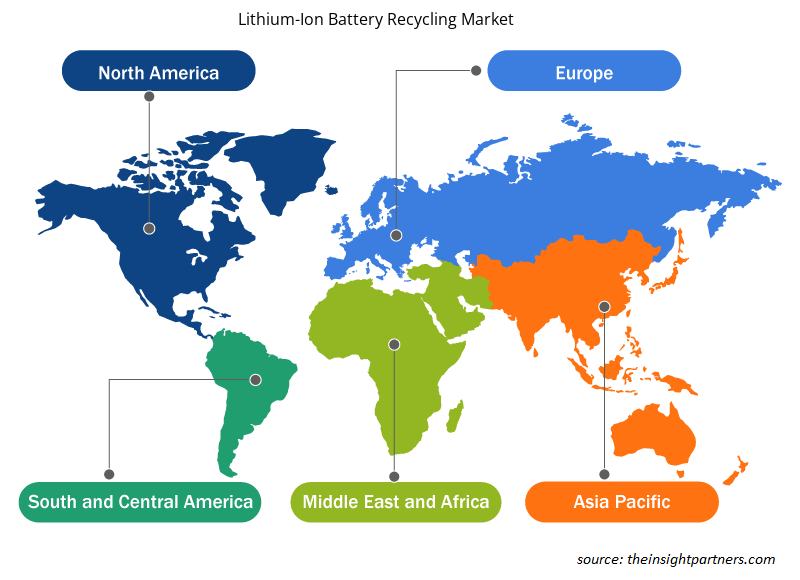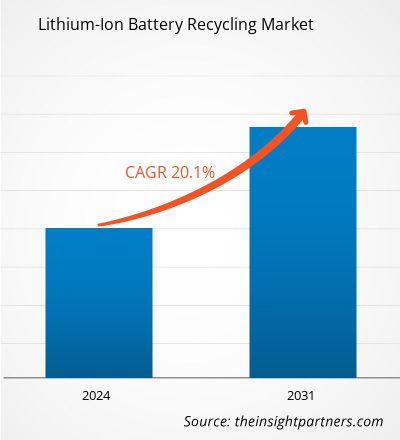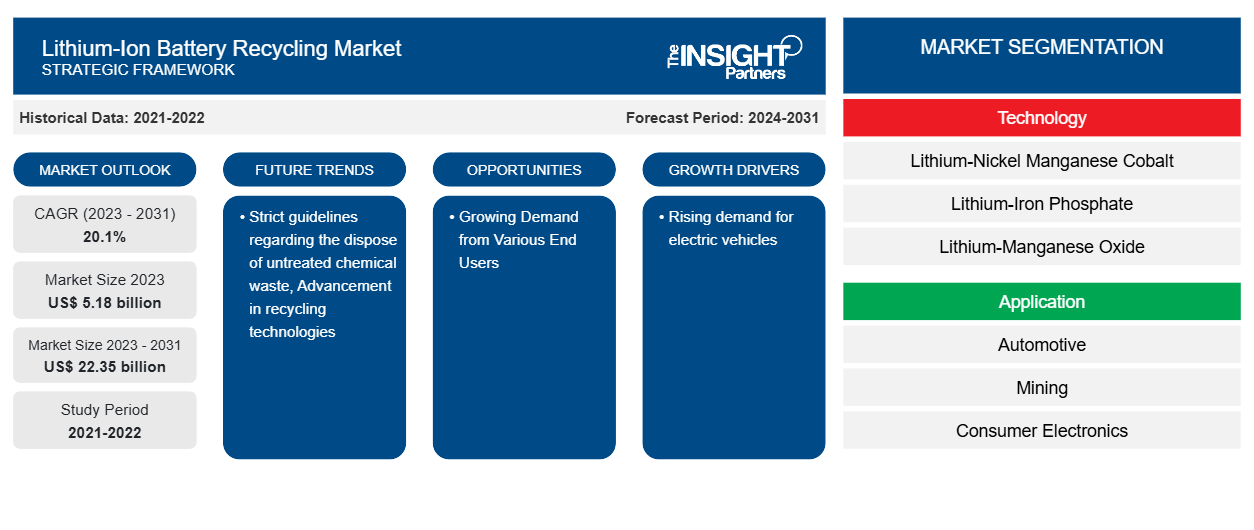锂离子电池回收市场规模预计将从 2023 年的 51.8 亿美元增长到 2031 年的 223.5 亿美元;预计 2023 年至 2031 年的复合年增长率为 20.1%。有关未经处理的化学废物处置的严格指导方针和回收技术的进步可能仍是锂离子电池回收市场的关键趋势。
锂离子电池回收市场分析
近年来,汽车行业对回收锂离子电池的需求大幅增加,尤其是在美国、德国、瑞典、挪威、荷兰和中国,以及一些东南亚发展中国家。国际能源署报告称,与 2020 年相比,2021 年电动汽车销量几乎翻了一番,达到 660 万辆(或近 9%),上路的电动汽车总数为 1650 万辆。此外,国际能源署预测,到 2030 年,上路的电动 汽车数量将超过 3 亿辆 ,这可能会导致锂离子电池回收量的增加。从本质上讲,消费者对该地区发展中国家电动汽车对环境的积极影响的认识不断提高,预计将刺激行业增长。制造商正专注于回收废旧锂离子电池,以满足汽车对它们的需求。
锂离子电池回收市场概况
锂离子电池 (LIB) 是一种电化学电池,包含电极和催化剂等组件,用于支持各种应用的发电。阴极和阳极管含有各种贵金属,储量有限,转售价格高。因此,锂离子电池的回收过程用于回收和销售电极组合物中收集的原材料,从而降低项目总体成本和影响。这些原因将有助于 锂离子电池回收市场的增长
锂离子电池在各种应用中的使用日益广泛,引发了人们对这种基本金属供应受限的担忧。这种金属的开采对环境有负面影响,包括化学品泄漏造成的水污染。因此,锂离子电池的回收利用最近有所增加。此外,由于目前没有其他材料具有与锂相似的特性,电池生产商越来越关注锂电池的再利用,以便为各种用途的电池提供适量的金属。在这方面,德国化学公司巴斯夫于 2021 年 6 月宣布计划在其位于施瓦茨海德的阴极活性材料 (CAM) 工厂开始建造一个新的电池回收和原型生产工厂。当锂离子电池达到使用寿命时,该公司打算使用增强方法提取钴、锰、锂和镍。
定制此报告以满足您的需求
您可以免费定制任何报告,包括本报告的部分内容、国家级分析、Excel 数据包,以及为初创企业和大学提供优惠和折扣
-
获取此报告的关键市场趋势。这个免费样品将包括数据分析,从市场趋势到估计和预测。
锂离子电池回收市场的驱动因素和机遇
电动汽车需求上升利好市场增长
电动汽车的日益普及是推动锂离子电池回收市场的主要因素之一。随着电动汽车的生产和销售量不断增加,回收使用寿命结束时的电池的需求变得越来越重要。随着人们对环境问题和温室气体排放影响的集体认识,全球正朝着更清洁、更可持续的交通方式发展。电动汽车已被证明是传统内燃机的可行替代品,因为它零排放。电池技术和电动汽车设计的不断改进增加了行驶里程,缩短了充电时间,并提高了电动汽车的整体性能。这使得电动汽车更加实用,对更广泛的人群更有吸引力,需求也随之增加。锂离子电池在电动汽车中的应用正在增加。电动汽车的使用率正在增加,这是由于一系列因素,例如能源效率较低、污染和消费者接受度,这些都是推动锂离子电池采用的因素之一。先进电池技术的发展和这些锂离子电池的最低维护要求也是电动汽车增长的因素。因此,由于锂离子电池的使用量不断增加,锂离子电池回收市场预计将继续增长。
据 BILITI Electric 估计,美国约有 300 万辆(55,555)电动汽车,约占道路上车辆总数的 1%。仅在 2022 年,55,555 家公司就生产了约 442,000 辆电动汽车。这表明汽车制造商的电动汽车产量大幅增加。
各类终端用户的需求不断增长——锂离子电池回收市场的机会
电气和电子行业是锂离子电池的最大用户之一,因为它可用于平板电脑、电脑、手机和其他电子设备。由于电气和电子行业的扩张,对这些能源的需求不断增加,尤其是在中国、印度和日本等不断发展的亚太国家。此外,由于终端用户行业的需求不断增加,回收锂离子电池的市场在未来几年有很大的扩张机会。此外,一些政府正在引进先进的电池回收技术。例如,2023 年 6 月,美国能源部 (DOE) 宣布额外提供超过 1.92 亿美元的资金,用于回收消费品中的电池、建立先进电池研发 (R&D) 合作项目以及继续实施 2019 年设立的锂离子电池回收奖。预计到 2027 年,电动汽车 (EV) 和固定式储能的需求将增长 10 倍以上,投资可持续、低成本的消费电池回收对于支持关键材料安全、有弹性和循环的国内供应链至关重要。
锂离子电池回收市场报告细分分析
有助于得出锂离子电池回收市场分析的关键部分是技术和应用。
- 根据技术,锂离子电池回收市场细分为锂镍锰钴、磷酸铁锂、锂锰氧化物、钛酸锂和锂镍钴铝氧化物。
- 根据应用,锂离子电池回收市场分为汽车、采矿、消费电子、工业和电力。
锂离子电池回收市场份额(按地区)分析
- 锂离子电池回收市场分为五大区域——北美、欧洲、亚太地区 (APAC)、中东和非洲 (MEA) 以及南美和中美。2023 年,亚太地区占据市场主导地位
- GS Yuasa Corporation、Umicore SA 等创新和知名供应商在整个地区的存在,是市场主导扩张的原因。电动汽车和商业和住宅应用的储能系统 (ESS) 等新兴和有吸引力的市场的出现,正在推动对 LIB 的需求。此外,将 ESS 与风能、太阳能和水力发电等可再生能源相结合,在技术和经济上都是必要的,以提高电网稳定性并推进 LIB 细分市场的发展。
锂离子电池回收市场区域洞察
Insight Partners 的分析师已详尽解释了预测期内影响锂离子电池回收市场的区域趋势和因素。本节还讨论了北美、欧洲、亚太地区、中东和非洲以及南美和中美洲的锂离子电池回收市场细分和地理位置。

- 获取锂离子电池回收市场的区域特定数据
锂离子电池回收市场报告范围
| 报告属性 | 细节 |
|---|---|
| 2023 年的市场规模 | 51.8亿美元 |
| 2031 年市场规模 | 223.5亿美元 |
| 全球复合年增长率(2023 - 2031) | 20.1% |
| 史料 | 2021-2022 |
| 预测期 | 2024-2031 |
| 涵盖的领域 |
按技术分类
|
| 覆盖地区和国家 |
北美
|
| 市场领导者和主要公司简介 |
|
市场参与者密度:了解其对商业动态的影响
锂离子电池回收市场正在快速增长,这得益于终端用户需求的不断增长,而这些需求又源于消费者偏好的不断变化、技术进步以及对产品优势的认识不断提高等因素。随着需求的增加,企业正在扩大其产品范围,进行创新以满足消费者的需求,并利用新兴趋势,从而进一步推动市场增长。
市场参与者密度是指在特定市场或行业内运营的企业或公司的分布情况。它表明相对于给定市场空间的规模或总市场价值,有多少竞争对手(市场参与者)存在于该市场空间中。
在锂离子电池回收市场运营的主要公司有:
- Ecobat 技术
- American Manganese Inc.(RecycLico Battery Material Inc.)
- 富腾
- 格林美有限公司
- 国际金属回收公司(INMETCO)
- Li-Cycle 公司
免责声明:上面列出的公司没有按照任何特定顺序排列。

- 了解锂离子电池回收市场的主要参与者概况
锂离子电池回收市场新闻和最新发展
通过收集一手和二手资料的定性和定量数据来评估点对点保险市场,其中包括重要的公司出版物、协会数据和数据库。以下是锂离子电池回收市场的发展情况:
- 2024 年 2 月,Omega Seiki Private Ltd (OSPL) 宣布已与 Attero 签署锂离子电池回收协议。根据合作,OSPL 与电子垃圾管理公司 Attero 计划在未来 3-4 年内回收超过 100MWh 的电池。
(来源:Omega Seiki Private Ltd,新闻稿)
- 2024 年 5 月,波士顿锂金属电池制造商 SES AI Corp. 宣布计划资助伍斯特理工学院 (WPI) 的一项新研究计划,以开发“最先进的”锂金属电池回收技术。
(来源:SES AI Corp,新闻稿)
锂离子电池回收市场报告内容及交付成果
“锂离子电池回收市场规模和预测(2021-2031)”对市场进行了详细的分析,涵盖了以下领域:
- 范围内所有主要细分市场的全球、区域和国家层面的市场规模和预测
- 市场动态,如驱动因素、限制因素和关键机遇
- 未来主要趋势
- 详细的 PEST/波特五力分析和 SWOT 分析
- 全球和区域市场分析涵盖关键市场趋势、主要参与者、法规和最新市场发展
- 行业格局和竞争分析,涵盖市场集中度、热点图分析、知名参与者和最新发展
- 详细的公司简介
- 历史分析(2 年)、基准年、预测(7 年)及复合年增长率
- PEST和SWOT分析
- 市场规模、价值/数量 - 全球、区域、国家
- 行业和竞争格局
- Excel 数据集
近期报告
相关报告
客户评价
购买理由
- 明智的决策
- 了解市场动态
- 竞争分析
- 客户洞察
- 市场预测
- 风险规避
- 战略规划
- 投资论证
- 识别新兴市场
- 优化营销策略
- 提升运营效率
- 顺应监管趋势























 获取免费样品 - 锂离子电池回收市场
获取免费样品 - 锂离子电池回收市场